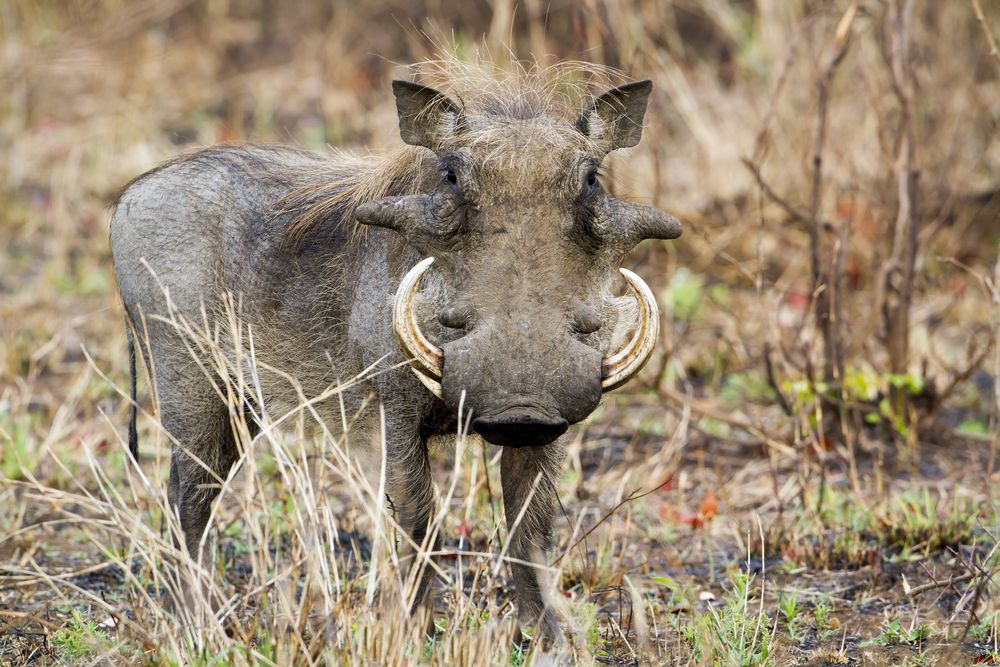
+- WildFact (https://wildfact.com/forum)
+-- Forum: Information Section (https://wildfact.com/forum/forum-information-section)
+--- Forum: Terrestrial Wild Animals (https://wildfact.com/forum/forum-terrestrial-wild-animals)
+---- Forum: Carnivorous and Omnivores Animals, Excluding Felids (https://wildfact.com/forum/forum-carnivorous-and-omnivores-animals-excluding-felids)
+---- Thread: Warthog (Phacochoerus africanus) (/topic-warthog-phacochoerus-africanus)
Warthog (Phacochoerus africanus) - epaiva - 06-01-2018

*This image is copyright of its original author

*This image is copyright of its original author
The common warthog is a medium-sized species, with a head-and-body length ranging from 0.9 to 1.5 m (3.0 to 4.9 ft), and shoulder height from 63.5 to 85 cm (25.0 to 33.5 in). Females, at 45 to 75 kg (99 to 165 lb), are typically a bit smaller and lighter in weight than males, at 60 to 150 kg (130 to 330 lb). A warthog is identifiable by the two pairs of tusks protruding from the mouth and curving upwards. The lower pair, which is far shorter than the upper pair, becomes razor-sharp by rubbing against the upper pair every time the mouth is opened and closed. The upper canine teeth can grow to 25.5 cm (10.0 in) long and have a wide elliptical cross section, being about 4.5 cm (1.8 in) deep and 2.5 cm (0.98 in) wide. A tusk will curve 90° or more from the root, and will not lie flat on a table, as it curves somewhat backwards as it grows. The tusks are used for digging, for combat with other hogs, and in defense against predators – the lower set can inflict severe wounds.It is taken from the constantly growing canine teeth. The tusks, particularly the upper set, work in much the same way as elephant tusks with all designs scaled down. Tusks are carved predominantly for the tourist trade in east and southern Africa.The head of the common warthog is large, with a mane down the spine to the middle of the back. Sparse hair covers the body. Its color is usually black or brown. Tails are long and end with a tuft of hair. Common warthogs do not have subcutaneous fat and the coat is sparse, making them susceptible to extreme environmental temperatures.
The common warthog is the only pig species that has adapted to grazing and savanna habitats. Its diet is omnivorous, composed of grasses, roots, berries and other fruits, bark, fungi, insects, eggs and carrion. The diet is seasonably variable, depending on availability of different food items. During the wet seasons, warthogs graze on short perennial grasses. During the dry seasons, they subsist on bulbs, rhizomes, and nutritious roots.Warthogs are powerful diggers, using both their snouts and feet. Whilst feeding, they often bend their front feet backwards and move around on the wrists. Calloused pads that protect the wrists during such movement form quite early in the development of the fetus. Although they can dig their own burrows, they commonly occupy abandoned burrows of aardvarks and other animals. The common warthog commonly reverses into burrows, with its head facing the opening and ready to burst out if necessary. Common warthogs will wallow in mud to cope with high temperatures and huddle together to cope with low temperatures.
Although capable of fighting (males aggressively fight each other during mating season), the common warthog's primary defense is to flee by means of fast sprinting. The common warthog's main predators are lions leopards cheetahs crocodiles African wilddog and hyenas Birds of prey such as Verreaux's eagle owls and martial eagles sometimes prey on piglets.
wikipedia
Credits to @huntuntamed and @grant_scott_photo
RE: Warthog (Phacochoerus africanus) - epaiva - 06-02-2018
Warthog skull
Credit to @natural_selections

*This image is copyright of its original author

*This image is copyright of its original author

*This image is copyright of its original author
RE: Warthog (Phacochoerus africanus) - Sanju - 01-09-2019
Its diet is omnivorous, composed of grasses, roots, berries and other fruits, bark, fungi, insects, eggs, carrion and sometimes even can hunt small live prey hen given oppurtunity (Kleiman, D.G., Geist, V., McDade, M.C. 2004).
That mother gazelle I think might had her child. So no experience in fawn raising and protecting. The fawn can't distinguish her mother and a pig and went directly into deadly jaws and fierce tusks. It munched on the baby's young body. Don't worry that hog's time will come when it will be ripped by hyena, crunched by a croc and shredded by a lion or leopard/a cheetah coalition then it will scream for the sin it did... (kidding).
Shame on you Pumba (lol

 )
)RE: Warthog (Phacochoerus africanus) - epaiva - 02-15-2019
Exhibited in Museo de Ciencias de Caracas, Venezuela

*This image is copyright of its original author

*This image is copyright of its original author
RE: Warthog (Phacochoerus africanus) - Sanju - 04-29-2019
Symbiosis :
RE: Warthog (Phacochoerus africanus) - BloodyClaws - 03-19-2020

*This image is copyright of its original author
Amazing specimen